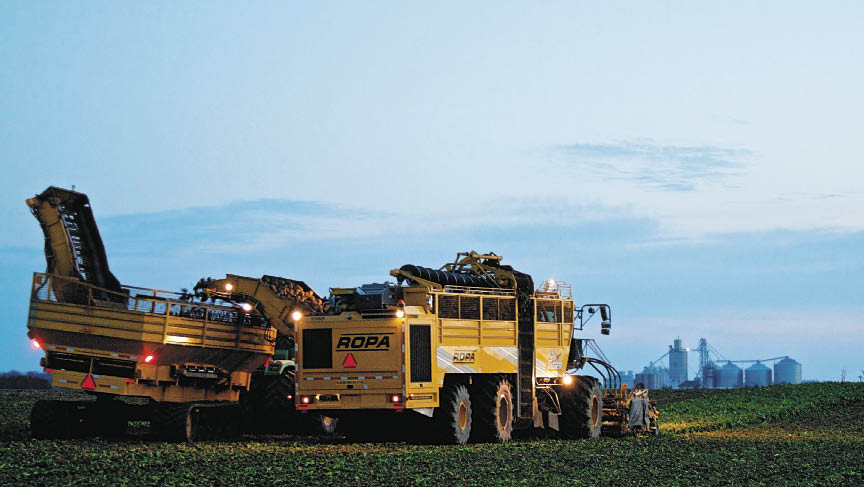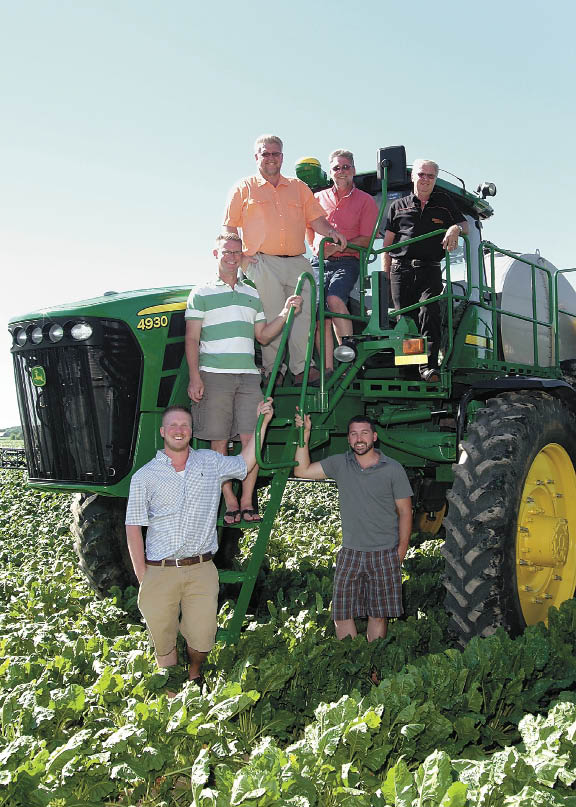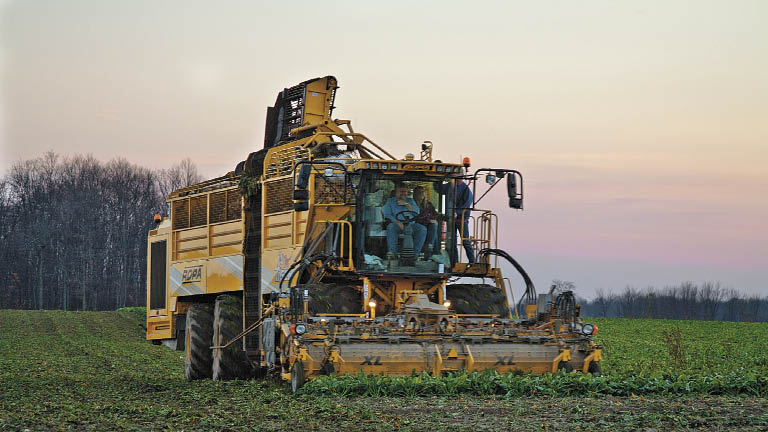 Keeping an even keel is imperative for sugarbeet growers.
Keeping an even keel is imperative for sugarbeet growers.
"Farming itself is a challenge," said Charlie Bauer, 58, of Laracha Farms in Reese, Mich. He's a partner in the operation with his brothers, Larry, 66, and Randy, 60. The partnership takes its title from the first name of each brother.
Ted, 41, Chad, 34, and Adam, 29, are also partners and represent the next generation. Adam, Charlie's son, joined four years ago. Larry's son, Ted, and Randy's son, Chad, bought in earlier.
There's no shortage of outside voices pointing out what's wrong or worrisome in agriculture.
"They want to tell you how bad things are," Charlie said, "whether it's too dry or too wet. My response to them is it's inconvenient, but that's farming. It's not cut and dried.
"You have to roll with both blessings and the things that aren't blessings," he said. "Rain can go from a blessing to a curse in about two hours."
It was an absence of moisture caused by the U.S. drought that impacted the 2012 harvest. The Bauers raise beets for the Michigan Sugar Company, a cooperative based in Bay City.
"Each year we seem to have a six- to 10- week dry spell where we don't have any rain," Charlie said.
The 2012 drought disaster did that and more on a much larger scale. According to the National Climatic Data Center, it was the largest drought in more than 50 years and among the 10 largest of the past century.
 Yet the Bauers got through it. Their operation includes 1,400 acres of beets, 1,800 of cucumbers, 1,200 of corn and 600 of dry edible beans.
Yet the Bauers got through it. Their operation includes 1,400 acres of beets, 1,800 of cucumbers, 1,200 of corn and 600 of dry edible beans.
"Last year the beets got in the ground early," Charlie said. "They were well developed when the drought hit and survived because they were good and healthy. Then they got the rain and put on tons."
Harvest ended up at 33.6 ton average per acre at 19.2 percent sugar content.
"It was higher than our average," Charlie said. "Our tonnage was certainly higher than our historic average. The Michigan Sugar Company average was around 29. We'd never been 4 tons above company average."
Part of the reason for a successful season included having 20-inch rows and good cover crops.
"We work really hard to control wind erosion on out beets," Charlie said. "We tiled extremely well. We work hard at keeping our beets healthy and disease free."
New season
"We planted about 240 acres of beets in early April," Charlie said. "They went through all the rain we had. They're doing really well. Then we got back in the field around May 3 and finished May 7."
Typically planting finishes April 15-20. But Mother Nature dictates timing. Last year the Bauers finished planting in March.
Michigan growers began using Roundup Ready in 2008 on about 50 percent of their sugarbeets.
"In 2009, we were at 100 percent," Charlie said. "What a blessing for the beet industry, also as far as yield. And the weed problem is resolved with Roundup Ready.
"Even though beet growing is intense, it's nothing like it was prior to Roundup Ready," he said. "We were spraying often, and every time you sprayed you used a lot of chemicals to keep weeds back."
The Bauers go to great lengths to control diseases.
"We plant nematode seed treatment where we need it," Charlie said. "In the spring we use in-furrow wet band and apply T-band Quadris and then put on four-to-five fungicide applications for Cercospora leaf spot."
Rhizoctonia is fought chemically and by having well-drained soils.
"We have the largest Rhizoc problem where we have standing water," Charlie said.
Harvesting made easier
One change made at harvest last year paid immediate dividends.
"We went to a Ropa self-propelled system," Charlie said.
The self-propelled machines-long used in Europe-are being promoted in North America for their labor saving and efficiency, compared to pull-behind models.
Canadian beet farmer John Noorloos, and his partner Eugen Burgin of Wyoming, Ontario, are president and secretary, respectively, for the distributor-Ropa North America Inc.
Noorloos said there were 48 of the Ropa harvesters in North America in 2012, mostly in the Michigan and Ontario area. This coming fall, he thinks up to 35 percent of beets in Michigan may be handled by Ropa alone.
Noorloos and Bergin raise beets for Michigan Sugar Company. They bought a Ropa for their own operations in 2002. Since buying the Ropa, they became the North American distributor and a regional dealer for their home area.
A Ropa has a 600-horsepower Mercedes diesel engine. Through a gearbox, it has 10 hydraulic pumps, which control hydraulic motors on the machine. The single machine defoliates, digs and hauls beets to the edge of a field with a 25-ton on-board bunker.
Instead of continuing to use 12-row and eight-row conventional harvesters, Charlie said Laracha Farms made the switch to using the Ropa nine-row self-propelled machine.
 "It eliminated the defoliators and everything and got rid of a lot of people in the field," he said. "With 20-inch rows, we had difficulty doing a really good job of harvesting. We felt the self-propelled machine would make a difference, and it was a huge difference time wise. The harvester just digs beets. You don't have to top them before. It's a one-pass operation.
"It eliminated the defoliators and everything and got rid of a lot of people in the field," he said. "With 20-inch rows, we had difficulty doing a really good job of harvesting. We felt the self-propelled machine would make a difference, and it was a huge difference time wise. The harvester just digs beets. You don't have to top them before. It's a one-pass operation.
"In 2011 we had a wet year, and it took everybody to harvest the beets," Charlie said. "We had to pull trucks. We couldn't start the corn until the beets were done, because it took everybody we had.
"And last year we had a wet fall, but Randy was done with the corn five days before I was done with the beets. It just made a huge difference for the operation."
Another change also proved a benefit.
"We decided rather than drive the trucks through the field, we were going to cart the beets," Charlie said. "And that system bodes well for that. We had two carts with the selfpropelled harvester. It's easier for the trucks, ground and everything."
Charlie believes more growers in Michigan will go with the self-propelled harvester.
"I think a dozen or so made the same switch last year and more will this year," he said. "You can be told about all the benefits and you can see them on paper but when you experience it, it's really amazing. We were very pleased."
Michigan's beet history
Reese is a village home to more than 1,450 residents in Tuscola and Saginaw counties in Michigan. Located almost entirely in Tuscola County's Denmark Township, the village includes only a tiny portion of Blumfield Township in Saginaw County.
Laracha Farms extends for more than 40 miles from its midpoint outside of Reese. It extends as far west to Saginaw. They ship beets from five to 20 miles to Michigan factories in Bay City, Caro and Sebewaing.
Charlie started farming with his father, Ruben, after graduating from high school in 1972. He also worked part time selling equipment for Art's-Way Manufacturing Company from 1988 to 2008. He helped develop the Art's-Way 6812 sugarbeet harvester.
"I worked with growers as far as Canada," he said. "I sold a lot of beet harvesters in Michigan, so I knew a lot of the farmers. I have a very clear view of the Michigan beet industry."
Charlie is vice chairman and a founding member of the Michigan Sugar Company and serves on the grower relations committee. He's also a board member of the American Sugarbeet Growers Association and the Sugar Association.
The board of directors of the Great Lakes Sugarbeet Growers Association purchased the company from Imperial Sugar in 2002. Monitor Sugar Company growers and Michigan Sugar Company merged and bought the Bay City factory in 2004.
Michigan's first sugarbeet campaign began in 1898. More than a century later the Michigan Sugar Company is the only remaining sugar company in the state and third largest in the country. It has more than 1,000 growerowners, employing 1,450 seasonal employees and 940 year-round employees. It generates nearly $400 million in direct economic activity annually in the local communities in which it operates. Its combined factories produce about 1 billion pounds of sugar annually.
Life on the farm
 "I'm proud to be a sugar grower," Charlie said. "It's a wonderful way to raise a family. You get to be with the kids, the nephews and the grandkids. They learn so much by just being along."
"I'm proud to be a sugar grower," Charlie said. "It's a wonderful way to raise a family. You get to be with the kids, the nephews and the grandkids. They learn so much by just being along."
Charlie and his wife, Terri, celebrated their 36th anniversary in July. Their daughter, Kelly, and her husband, Erik Reinhardt, have two children, Hannah and Brady.
"My grandson, Brady, spends a lot of time in the spray with me and the beet harvester," Charlie said. "Although he's only 5 you cannot imagine how much he picks up just be being around."
Charlie said Laracha Farms helps support six or seven families in addition to the partners.
"As growers we need to be proud of what we're doing and keep doing more and more to help educate people about farming and the importance of food and the safety of it.
"I think the future looks good if we get this farm bill," he added. "Sugar is a natural safe product that has been used for centuries. There's nothing artificial in it. We need to produce as much of this important food staple as we can domestically to ensure a safe stable supply. It's critical."